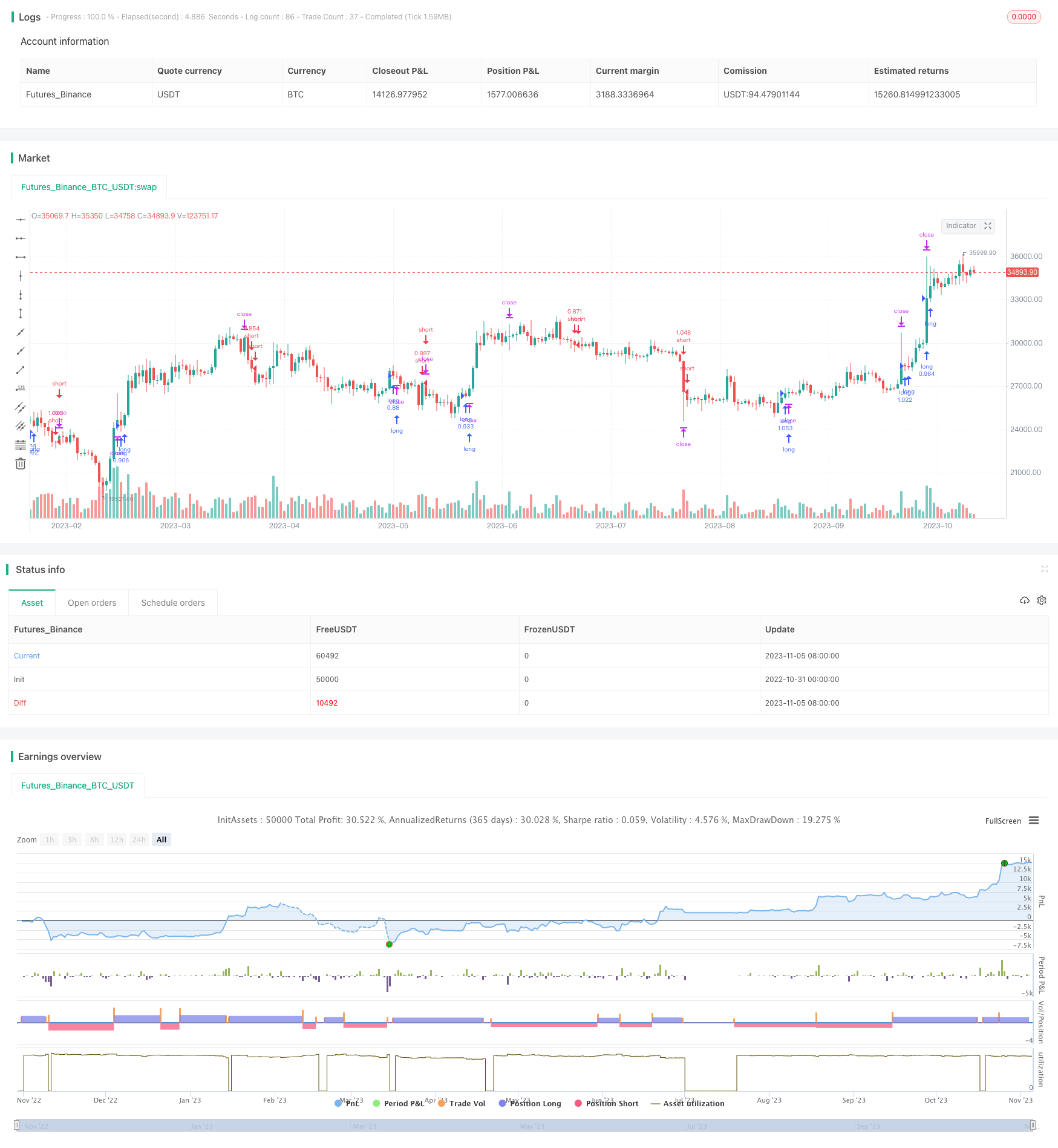
概述
多指标评分交易策略通过整合技术指标评分,识别趋势方向和力度,实现自动交易。该策略综合考虑一组指标,包括Ichimoku云,HMA,RSI,Stoch,CCI和MACD。根据每个指标的结果,为其评分,然后综合所有指标的评分,形成一个整体评分。当整体评分高于阈值时做多,低于阈值时做空。
策略原理
该策略由多个部分组成:
计算一组指标,包括Ichimoku云,Hull移动平均线,相对强弱指数,随机指标,商品通道指数和移动平均线敏感度。
对每个指标进行评分。当指标显示多头信号时给予正分,空头信号时给予负分。
将所有指标评分进行求和平均,得到一个综合评分。
将综合评分与事先设定的阈值进行比较,判断整体趋势方向。评分高于阈值时看多,低于阈值时看空。
根据判断结果进行开仓。当看多时做多,看空时做空。
止损停利通过ATR指标设定。
该策略充分利用了多种指标的优势,综合判断市场趋势方向。相比单一指标,能够过滤掉部分虚假信号,提高信号的可靠性。
优势分析
该策略具有以下优势:
多指标综合判断,提高信号准确率。单一指标容易产生误判,该策略通过评分求平均的方式,能有效过滤虚假信号。
利用指标优势,识别趋势和目前力度。例如Ichimoku云判断大趋势,Stoch判断超买超卖。
自动交易避免情绪影响,严格执行策略信号。
使用ATR设定止损停利点,有利于风险控制。
可以针对不同品种进行参数调优。指标参数和评分阈值都可以优化。
策略逻辑简单清晰,易于理解和修改。
风险分析
该策略也存在以下风险:
多指标组合不一定优于单一指标,需要反复测试找到最佳参数。
指标发出错误信号时,评分求平均也无法完全避免损失。
ATR止损可能过于接近或过于宽松,需要根据品种特点调整。
需要避免过度优化而导致的曲线拟合。应在不同品种和时间段测试策略稳健性。
交易频率可能过高,交易成本也会影响最终收益。
优化方向
该策略可以从以下几个方面进行优化:
测试更多指标的组合,找到对特定品种最优的指标选择。
调整每个指标的评分权重,优化评分算法。
动态调整ATR参数,使止损停利更贴合市场波动。
加入交易过滤条件,减少不必要的交易频率。例如趋势过滤,交易量过滤等。
进行步进优化找到参数优化区间,再随机/网格优化寻找最佳参数组合。
在多品种多时间框架测试策略稳健性,避免过度优化。
组合其他有效交易策略,形成策略组合。
总结
多指标评分交易策略通过评分求平均的思路,提高了信号判断的准确性和可靠性。该策略参数调优空间大,可针对不同品种进行优化得到较好效果。但是也需要注意过优化的风险,保持参数优化和策略测试的科学性。作为一种优化方向广阔的交易策略思路,值得进一步研究和应用。
/*backtest
start: 2022-10-31 00:00:00
end: 2023-11-06 00:00:00
period: 1d
basePeriod: 1h
exchanges: [{"eid":"Futures_Binance","currency":"BTC_USDT"}]
*/
//@version=4
strategy(title="Ichi HMA RSI Stoch CCI MACD Technicals Rating Strategy",shorttitle="TRSv420",overlay=true,default_qty_type=strategy.percent_of_equity,default_qty_value=50,commission_type=strategy.commission.percent,commission_value=0.05)
res = input("", title="Indicator Timeframe", type=input.resolution)
Period = input(defval = 14, title = "Period Length", minval = 2)
MinSignalStrength= input(title="Minimum Signal Strength", type=input.float, defval=1.1, minval=0.00, maxval=2.00, step=0.1)
Price = input(defval=open, title="Price Source", type=input.source)
Use_Only_Buy= input(false, title = "Use ONLY BUY mode",type=input.bool)
Use_Only_Sell= input(false, title = "Use ONLY SELL mode",type=input.bool)
Use_ATR_SL_TP= input(true, title = "Use ATR for TP & SL",type=input.bool)
Use_Ichimoku= input(true, title = "Use Ichimoku",type=input.bool)
Use_HMA= input(true, title = "Use Hull MA",type=input.bool)
Use_RSI= input(true, title = "Use RSI",type=input.bool)
Use_Stoch= input(true, title = "Use Stoch",type=input.bool)
Use_CCI= input(true, title = "Use CCI",type=input.bool)
Use_MACD= input(true, title = "Use MacD",type=input.bool)
// Ichimoku Cloud
donchian(len) => avg(lowest(len), highest(len))
ichimoku_cloud() =>
conversionLine = donchian(9)
baseLine = donchian(26)
leadLine1 = avg(conversionLine, baseLine)
leadLine2 = donchian(52)
[conversionLine, baseLine, leadLine1, leadLine2]
[IC_CLine, IC_BLine, IC_Lead1, IC_Lead2] = ichimoku_cloud()
calcRatingMA(ma, src) => na(ma) or na(src) ? na : (ma == src ? 0 : ( ma < src ? 1 : -1 ))
calcRating(buy, sell) => buy ? 1 : ( sell ? -1 : 0 )
calcRatingAll() =>
//============== HMA =================
HMA10 = hma(Price, Period)
HMA20 = hma(Price, 20)
HMA30 = hma(Price, 30)
HMA50 = hma(Price, 50)
HMA100 = hma(Price, 100)
HMA200 = hma(Price, 200)
// Relative Strength Index, RSI
RSI = rsi(Price,14)
// Stochastic
lengthStoch = 14
smoothKStoch = 3
smoothDStoch = 3
kStoch = sma(stoch(Price, high, low, lengthStoch), smoothKStoch)
dStoch = sma(kStoch, smoothDStoch)
// Commodity Channel Index, CCI
CCI = cci(Price, 20)
// Moving Average Convergence/Divergence, MACD
[macdMACD, signalMACD, _] = macd(Price, 12, 26, 9)
// -------------------------------------------
PriceAvg = hma(Price, Period)
DownTrend = Price < PriceAvg
UpTrend = Price > PriceAvg
float ratingMA = 0
float ratingMAC = 0
if(Use_HMA)
if not na(HMA10)
ratingMA := ratingMA + calcRatingMA(HMA10, Price)
ratingMAC := ratingMAC + 1
if not na(HMA20)
ratingMA := ratingMA + calcRatingMA(HMA20, Price)
ratingMAC := ratingMAC + 1
if not na(HMA30)
ratingMA := ratingMA + calcRatingMA(HMA30, Price)
ratingMAC := ratingMAC + 1
if not na(HMA50)
ratingMA := ratingMA + calcRatingMA(HMA50, Price)
ratingMAC := ratingMAC + 1
if not na(HMA100)
ratingMA := ratingMA + calcRatingMA(HMA100, Price)
ratingMAC := ratingMAC + 1
if not na(HMA200)
ratingMA := ratingMA + calcRatingMA(HMA200, Price)
ratingMAC := ratingMAC + 1
if(Use_Ichimoku)
float ratingIC = na
if not (na(IC_Lead1) or na(IC_Lead2) or na(Price) or na(Price[1]) or na(IC_BLine) or na(IC_CLine))
ratingIC := calcRating(
IC_Lead1 > IC_Lead2 and Price > IC_Lead1 and Price < IC_BLine and Price[1] < IC_CLine and Price > IC_CLine,
IC_Lead2 > IC_Lead1 and Price < IC_Lead2 and Price > IC_BLine and Price[1] > IC_CLine and Price < IC_CLine)
if not na(ratingIC)
ratingMA := ratingMA + ratingIC
ratingMAC := ratingMAC + 1
ratingMA := ratingMAC > 0 ? ratingMA / ratingMAC : na
float ratingOther = 0
float ratingOtherC = 0
if(Use_RSI)
ratingRSI = RSI
if not(na(ratingRSI) or na(ratingRSI[1]))
ratingOtherC := ratingOtherC + 1
ratingOther := ratingOther + calcRating(ratingRSI < 30 and ratingRSI[1] < ratingRSI, ratingRSI > 70 and ratingRSI[1] > ratingRSI)
if(Use_Stoch)
if not(na(kStoch) or na(dStoch) or na(kStoch[1]) or na(dStoch[1]))
ratingOtherC := ratingOtherC + 1
ratingOther := ratingOther + calcRating(kStoch < 20 and dStoch < 20 and kStoch > dStoch and kStoch[1] < dStoch[1], kStoch > 80 and dStoch > 80 and kStoch < dStoch and kStoch[1] > dStoch[1])
if(Use_CCI)
ratingCCI = CCI
if not(na(ratingCCI) or na(ratingCCI[1]))
ratingOtherC := ratingOtherC + 1
ratingOther := ratingOther + calcRating(ratingCCI < -100 and ratingCCI > ratingCCI[1], ratingCCI > 100 and ratingCCI < ratingCCI[1])
if(Use_MACD)
if not(na(macdMACD) or na(signalMACD))
ratingOtherC := ratingOtherC + 1
ratingOther := ratingOther + calcRating(macdMACD > signalMACD, macdMACD < signalMACD)
ratingOther := ratingOtherC > 0 ? ratingOther / ratingOtherC : na
float ratingTotal = 0
float ratingTotalC = 0
if not na(ratingMA)
ratingTotal := ratingTotal + ratingMA
ratingTotalC := ratingTotalC + 1
ratingTotal := ratingTotal + ratingOther
ratingTotalC := ratingTotalC + 1
ratingTotal := ratingTotalC > 0 ? ratingTotal / ratingTotalC : na
[ratingTotal, ratingOther, ratingMA, ratingOtherC, ratingMAC]
[ratingTotal, ratingOther, ratingMA, ratingOtherC, ratingMAC] = security(syminfo.tickerid, res, calcRatingAll(), lookahead=false)
tradeSignal = ratingTotal+ratingOther+ratingMA
dynSLpoints(factor) => factor * atr(14) / syminfo.mintick
if not (Use_Only_Sell)
strategy.entry("long", strategy.long, when = tradeSignal > MinSignalStrength)
if not (Use_Only_Buy)
strategy.entry("short", strategy.short, when = tradeSignal < -MinSignalStrength)
if(Use_ATR_SL_TP)
strategy.exit("sl/tp", loss = dynSLpoints(3), trail_points = dynSLpoints(5), trail_offset = dynSLpoints(2))